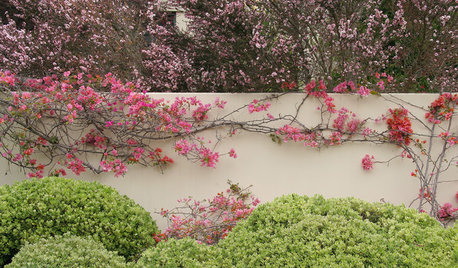Honeycrisp Vs. Heat
applenut_gw
15 years ago
Related Stories

LANDSCAPE DESIGNThe Art of the Espalier
Go ahead, let limited garden space drive you up the walls. With these 6 ways to train plants vertically, it can be a beautiful thing
Full StoryI had the best Honeycrisp in my life today, probably because it was the first truly ripe one IÂve ever had (the ones in the supermarket all have pale seeds and lots of green skin).
It was grown locally in Oak Glen, a foothill region at 5000Â elevation (yes, thatÂs foothills to us compared to the 11,000Â peaks) that gets 2000 chilling hours annually, but also gets stinking hot in the summer, occasionally hitting 100 degrees. Winter temps stay balmy, usually hitting the 60s. This made me think of trying it again down here.
I have a Honeycrisp on M27 that never did anything, and I just assumed that it was bad in this climate; however, today I discovered the trunk was riddled with borers with only a thin strip left, and may have been this way since last year. IÂm thinking of trying it on a more vigorous rootstock, and wondered if anyone grows Honeycrisp where you get lots of heat.
I realize our lack of chill isn't supposed to be condusive to apples, but that has not been a problem.





fruitnut Z7 4500ft SW TX
applenut_gwOriginal Author
Related Professionals
West Milford Landscape Architects & Landscape Designers · Graham Landscape Architects & Landscape Designers · Sahuarita Landscape Architects & Landscape Designers · Aurora Landscape Contractors · Athens Landscape Contractors · Lady Lake Landscape Contractors · Long Beach Landscape Contractors · Mashpee Landscape Contractors · Mercedes Landscape Contractors · Paramus Landscape Contractors · San Bruno Landscape Contractors · West Haverstraw Landscape Contractors · West Haverstraw Landscape Contractors · Whittier Landscape Contractors · New Carrollton Landscape ContractorsEmbothrium
fruitnut Z7 4500ft SW TX
nimzo
applenut_gwOriginal Author
zeuspaul
Scott F Smith
athenainwi
geraldo_linux
sautesmom Sacramento
Axel
Axel
applenut_gwOriginal Author
Axel
joeker
applenut_gwOriginal Author
thomis